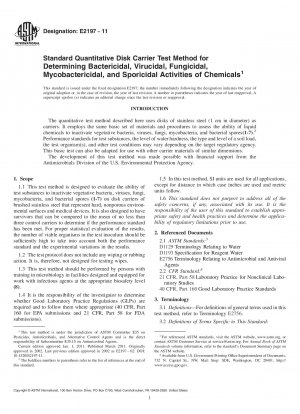ASTM E2197-11
Standard Quantitative Disk Carrier Test Method for Determining the Bactericidal, Virucidal, Fungicidal, Mycobactericidal and Sporicidal Activities of Liquid Chemical Germicides
- Standard No.
- ASTM E2197-11
- Release Date
- 2011
- Published By
- American Society for Testing and Materials (ASTM)
- Status
- Replace By
- ASTM E2197-17
- Latest
- ASTM E2197-17e1
- Scope
The design of this test eliminates any loss of viable organisms through wash off, thus making it possible to produce statistically valid data using many fewer test carriers than needed for methods based on simple MPN estimates.
The stringency in the test is provided by the use of a soil load, the microtopography of the brushed stainless steel carrier surface, and the smaller ratio of test substance to surface area typical for many disinfectant applications. Thus, the test substance being assessed is presented with a reasonable challenge while allowing for efficient recovery of the test organisms from the inoculated carriers. The metal disks in the basic test are also compatible with a wide variety of actives.
The design of the carriers makes it possible to place onto each a precisely measured volume of the test organism (10 μL) as well as the control fluid or test substance (50 μL).
The inoculum is placed at the center of each disk whereas the volumes of the test substance covers nearly the entire disk surface, thus virtually eliminating the risk of any organisms remaining unexposed.
In all tests, other than those against viruses, the addition of 10 mL of an eluent/diluent gives a 1:200 dilution of the test substance immediately at the end of the contact time. While this step in itself may be sufficient to arrest the microbicidal activity of most actives, the test protocol permits the addition of a specific neutralizer to the eluent/diluent, if required. Except for viruses, the membrane filtration step also allows processing of the entire eluate from the test carriers and, therefore, the capture and subsequent detection of even low numbers of viable organisms that may be present. Subsequent rinsing of the membrane filters with saline also reduces the risk of carrying any inhibitory residues over to the recovery medium. Validation of the process of neutralization of the test substance is required by challenge with low numbers of the test organism.
In tests against viruses, addition of 1 mL of buffer at the end of the contact time achieves a 1:20 dilution of the test substance while keeping the volume of the eluate reasonably small to allow for the titration of most or all of the eluate in cell cultures. Confirmation of neutralization of the test substance is required by challenge of a residual disinfection load with low numbers of infective units of the test virus. Since the virus assay system is indirect, an additional step is required to demonstrate that prior exposure of the appropriate cell line to any residual disinfectant or disinfectant/neutralizer mixture does not interfere with the detection of a low level of virus challenge (See Appendix).
Note 18212;In 5.5 and 5.6, volumes of 10 mL and 1 mL are recommended instead of 9.95 mL and 950 μL, respectively, for ease of dispensing the eluent.
The soil load in this test is a mixture of three types of proteins (high molecular weight proteins, low molecular weight peptides, and mucous material) designed to represent body secretions, excretions, or other extraneous substances that microbicidal chemicals may encounter under field conditions. It is suitable for working with all types of test organisms included here. The components of the soil load are readily available and subject to much less variability than animal sera.
If distilled water or other diluent is not to be specified on the product label, the diluent for the test substance is assumed to be tap water. Since the quality of tap water varies considerably both geographically and temporally, this test method incorporates the use of water with a specified and documented level of hardness to prepare use-dilutions of test substance that require dilution in water before use. While water with..........
ASTM E2197-11 Referenced Document
- ASTM D1129 Standard Terminology Relating to Water
- ASTM D1193 Standard Specification for Reagent Water
- ASTM E2756 Standard Terminology Relating to Antimicrobial and Antiviral Agents
ASTM E2197-11 history
- 2017 ASTM E2197-17e1 Standard Quantitative Disk Carrier Test Method for Determining Bactericidal, Virucidal, Fungicidal, Mycobactericidal, and Sporicidal Activities of Chemicals
- 2017 ASTM E2197-17 Standard Quantitative Disk Carrier Test Method for Determining Bactericidal, Virucidal, Fungicidal, Mycobactericidal, and Sporicidal Activities of Chemicals
- 2011 ASTM E2197-11 Standard Quantitative Disk Carrier Test Method for Determining the Bactericidal, Virucidal, Fungicidal, Mycobactericidal and Sporicidal Activities of Liquid Chemical Germicides
- 2002 ASTM E2197-02 Standard Quantitative Disk Carrier Test Method for Determining the Bactericidal, Virucidal, Fungicidal, Mycobactericidal and Sporicidal Activities of Liquid Chemical Germicides
